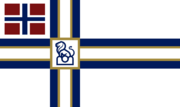Erania
Republic of Erania אַינאַרע קילבופּר Republikh Erania | |
|---|---|
|
Flag | |
| Motto: טסעפֿ טואַיאָל ןי Acro-Erani: In Loyalty Steadfast | |
| Capital | Avtalyon |
| Largest city | Tiber |
| Official languages | Acro-Erani Erani Nordic Hellenic |
| Recognised regional languages | Venetian Condotierro |
| Demonym(s) | Erani Eranian |
| Government | Federal parliamentary constitutional monarchy |
| Area | |
• Total | 488,530 km2 (188,620 sq mi) |
| Population | |
• 2022 census | 40,134,503 |
| Currency | Mark (ƒ) (ERM) |
| Date format | dd-mm-yyyy CE |
| Driving side | right |
| Calling code | +63 |
| ISO 3166 code | ERN |
| Internet TLD | .ern |
Erania, officially the Republic of Erania, is a country located in Siduri in Tyran. It is bordered to the west by Knichus and to the south by Lemobrogia.
The territory that is now Erania has been inhabited by a variety of peoples indigenous to that region of Siduri, but at the time of Erani migration eastward was populated predominantly by Sidi tribes, indigenous groups originating from modern day Knichus. The oral history of both the Erani and Sidi states that this was a significant period of conflict in Erania, during which the migrating tribes forced the Sidi westward, an event which serves as the root of Erani-Sidi enmity to the present. Although no written records of this period are known exist, the narrative is supported by archaeological work performed primarily by Erani, Syaran, and Acrean scholars. The first written account of Erania comes from a Symmerian traveler named ____, who wrote about his experiences with the Erania in 481. Erania was conquered by the Symmerians in 665 following the Sabrian Wars.
Symmerian rule marked a profound change in traditional Erani society and culture as it experienced significant social, cultural, and demographic changes. Prior to the Symmerians, the idea of Erania as a single polity was a fringe concept amongst the Erani themselves, who often regarded each other based on their tribal allegiances rather than as a singular people.
Erania remained an Acrean territory until the 20th century. It was granted co-equal status with Acrea in the Riksdag in 1947, and later ratified and adopted its own constitution in 1990, making Erania fully independent.
Today, Erania is a developed country with a moderately high mean income. Technology and agriculture form the majority of its economy, whose competing interests have been a longstanding focal point of political debate within the country. Erania maintains a professional standing army, resulting from its highly militarised status under Acrean rule as well as the cultural disposition of both its native and colonial-descent populations.
